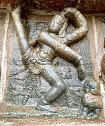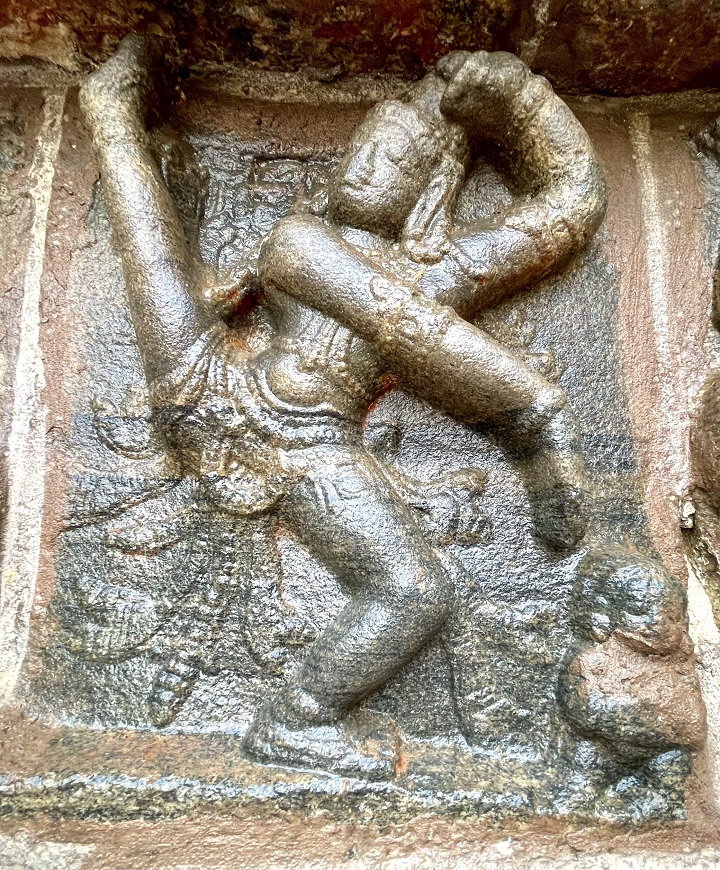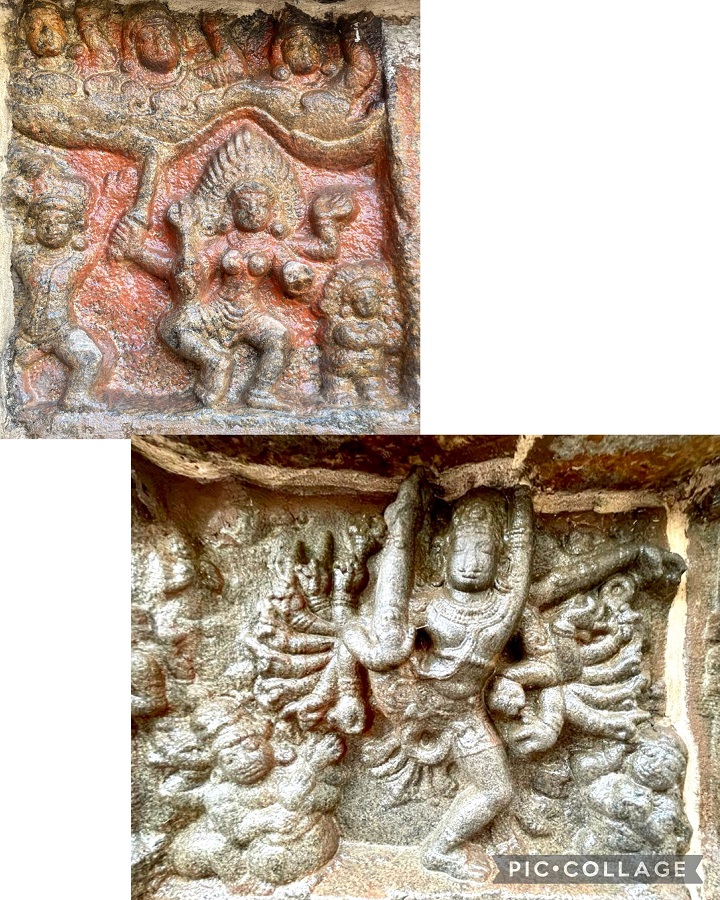 |
 |
 |
http://www.varalaaru.com A Monthly Web Magazine for South Asian History [187 Issues] [1839 Articles] |
 |
 |
 |
http://www.varalaaru.com A Monthly Web Magazine for South Asian History [187 Issues] [1839 Articles] |
|
Issue No. 175

இதழ் 175 [ ஃபிப்ரவரி 2024 ] 
இந்த இதழில்.. In this Issue.. 
|
Author: www.glorioustamils.com; www.attraithingal.com Karaikkal Ammaiyar’s works- Arputha Thiruvandhaathi, Irattai Manimaalai and Mootha Thiruppathigam are the first Indian literary evidences available till date, for a list of exceptional events related to the rise of Shiva as the Supreme Dancer. These events can be classified as mythology or when analysed further be identified as history over shadowed by the gloss of religious beliefs. What are those firsts? Her poetry is the earliest in the Indian Bhakti movement to extensively showcase Shiva's fiercest of dances in the graveyard. She was the pioneer saint to portray in words the different legendary forms of Shiva related to puranic stories that reverberated throughout the Bhakti era. It is also a less known fact that the attributes of the iconographic representation of Dancing Shiva in His Ananda Tandava pose, glorified in the temples built and renovated by the Chola Queen Mother Chembian Madevi, is based on Ammai’s descriptions in her three works 1. The essence of Ammai’s hymns is undoubtedly Shiva, the intense dance of Shiva, His fiery attitude, His numerous attributes, puranic tales and everything else that eulogises Shiva as the foremost of all Gods. To emphasise the position of Shiva as the outstanding Dancer of the era, comes the story of dance competition between Shiva and Kali, where the male dancer claims superiority by the simple lift of leg. Still, there is a cloud of enigma that surrounds the elevation of Shiva as the ecstatic and unparalleled Dancer.  Sarngapani temple, Kumbakonam For this purpose, let us pose a few precise querries with the spotlight on Kariakkal Ammai’s Mootha Thiruppathigam, which hails the most powerful Dance of Shiva in the graveyard. • Was Shiva already the established Supreme Dancer in Tamilagam? • When was He crowned so and How? • Are there any literary evidences for His crowning moment? Diving deep into the rich documented tamil literary works squeezed between post Sangam and Bhakti eras of yesteryear Tamilagam would aid in clearing certain bothersome ambiguities. Kalithogai Kalithogai that belongs to the last years of Sangam period seems to be the first available source to introduce Shiva as the eternal dancer. In Kalithogai's ‘kadavul vaazhthu’ or invocation to God, He dances the Kodukotti, Pandarangam and Kabaala koothu. He performs ‘Kodukotti’ assuming different appearances amidst the echoing sounds of Parai; Victorious after winning several wars He dances the ‘Pandarangam' applying thiruneeru/sacred ash all over His body; In Kabaala Koothu, He dances with the skull in his palm, wears the skin of a tiger on his waist and garland made of kondrai flowers hangs from his neck. Umai adorning exquisite ornaments provides the three beats – paani, seer and thooku to apparently add flavour to His dance. Silappadhikaram Next in timeline, Silappadhikaaram shows the increased religious inclination of the tamil society and is the first tamil literary source to associate Dance with Gods on a large scale. Author Ilangovadigal introduced and immortalised young girl Madhavi, the most adored dance artist of Tamilnadu till date. The talented Madhavi was not only bestowed upon with the revered sceptre of Dance – Thalaikol in recognition of her great maiden performance, but also showered with the highest rewards of the State— special garland from the King, the honour of Thalaikoli, and 1008 kazhanju of gold. (Silambu, Arangetru Kaathai, 158-165). Also, there is a long line of strong female characters in Silambu- Kannagi, Madhavi, Madhavi’s mother Chitrapathy, Kannaki’s friend Devanthi, who later becomes the first priest of the Kannagi temple built by Cheran Chenguttuvan, Madhavi’s friend Vasanthamalai, Jain monk Kavunthi Adigal, Madhari- the lady, who provided refuge for Kannagi in Madurai, Madhari’s daughter Aiyai, Pandian Nedunchezhian’s Queen Kopperundevi and Venmaal- Senguttuvan’s Queen. Furthermore, Kovalan’s family deity was Manimegalai, the venerated name he chose for his daughter. Madhavi’s performance of 11 kinds of Dances in Kadalaadu Kaathai classifies the dances of different Gods- • Kodukotti and Pandarangam performed by Shiva • Alliya thoguthi performed by Krishna • Mallaadal and Kudakoothu (with a pot) performed by Thirumal • Thudikoothu and Kudaikoothu (with an umbrella) performed by Murugan • Pedi Aadal performed by Kaaman/Manmadhan • Marakkaal Aadal performed by Maayaval or Kotravai • Paavai Aadal performed by Thirumagal • Kadaiakkoothu performed by Indrani Shiva is only one among the 8 divine dancers, and He performs only two of the 11 dances. Hence it appears, He was not yet crowned as the unparalleled dancer. Next, in ‘vazhakkurai kaathai’, a raging Kannagi arrives at the entrance of the court of Pandian Nedunchezhian, seeking justice for her husband’s unjust killing. Here, Ilangovadigal compares Kannagi to Kali. He describes Kali through the voice of the guard, in four different connotations- அறுவர்க் கிளைய நங்கை இறைவனை ஆடல்கண்டு அருளிய அணங்கு சூருடைக் கானகம் உகந்த காளி தாருகன் பேருரம் கிழித்த பெண் (vazhakkurai kaathai : 38-41) 1. she is youngest of the seven virgin sisters 2. she is Anangu, who blessed Shiva to be winner of the dance contest / field of dance 3. she is Kali who belongs to the forest 4. she is the dame who tore darukan to pieces In a screenplay with such impactful sequences and characters, it is very easy to ignore the undercurrent of two subtle hints here. One is Anangu who lost supremacy over her dance field and the other is the rage of Kannagi that Ilango compares to that of Kali. Firstly, Anangu. ‘Iraivanai aadal kandu aruliya Anangu’ could simply mean, the lady who let Shiva lead the dance floor. Among the four comparisons of Kannagi to Kali, one shows her dwelling in the forest and one sheds light on the dance field. Ilangovadigal doesn’t mince words here. He clearly states that Anangu of the forest blessed Shiva to reign over the world of dance. There is no mention of any competition/fight/ struggle, but Kali lost the dance field that always belonged to her. She who held the Supreme position, gave away Her position to Shiva. The period that followed the epic era was bhakti era, skilfully led by Karaikkal Ammai, one of the pioneer saints before Appar and Sambandar. Ammai’s Mootha Thiruppathigam provides a clearer description to the verses of Silappadhikaram, where Kali lost her dance field. She introduces to the world, the Lead Dancer of her era - Shiva. At this time in history, Shiva is crowned as the Lord of the dance field. Yet another crucial development between the periods of Silambu (epic era) and early years of bhakti movement can be sensed from Ammai’s poetry. The names of Anangu and Kali mentioned by Ilango continues to echo in Ammai’s verses. Ammai reveals in three places in her Mootha Thiruppathigam that the stage had always belonged to Kali, the Goddess of Dance and Shiva presently dances in the forest of Thiruvalangadu, where Anangu used to Dance (‘அணங்கு காட்டில் இறைவன் ஆடுமே’) 2. Hence, Kali, who lost her dance field during epic era, lost her forest too by the time bhakti era took over in Tamil Land. The dance arena of the star performer of Karaikkal Ammai was the forest, precisely the forest of Thiruvalangadu. The second hint provided by Ilangovadigal is the rage of Kannagi. An immersed reader understands the cause of Kannagi’s exasperation. But, what could be the fury of Kali, that made the author of Silambu equate it with the loss of his protagonist Kannagi? It is unambiguously the loss of her sovereignty over the well rooted dance domain of the vast Tamil Land. The similar sense of loss, helplessness and anger over injustice can be sensed from the annoyance and resentment of both these women. Ilango’s comparative announcement of both losses - one of a woman’s husband and thereby her hope for a harmonious life and; the other being a loss of identity, self respect and dignity. Both were lawfully unjust, life changing events. The catastrophe in Kannagi’s life caused great disaster and damage - personal and political; whereas that of Kali brought in colossal transformations - religious and cultural in the tamil society. The Contest - a forceful social change Beyond specifying the forest that belonged to Anangu, there is one more striking manifestation in Ammai’s Mootha Thiruppathigam. Those powerful words bring to spotlight an important event - the contest between Kali and Shiva, the outcome of which should have been a forceful social change during her times. The verses of Mootha Thiruppathigam in focus are no more than two- மண்டலம் நின்றங் குளாளம்இட்டு வாதித்து வீசி எடுத்தபாதம் அண்டம் உறநிமிர்ந் தாடும்எங்கள் அப்பன் இடந்திரு ஆலங்காடே (mootha thiruppathigam 4)  Sarngapani temple, Kumbakonam There are three dance steps performed by Shiva here. 1. ’mandalam nindru’ - He stands in mandala- the half squat basic position that dancers start their performances with; 2. ’veesi edutha paadham’ - Then, He throws His leg upwards 3. ’andamura nimirndhaadum’ - Further on, He throws His leg to reach the skies. There are two more highly expressive activities that are represented- ‘ulaalam ittu’ and ‘vaathithu’. Ullaalam is the voice variation given out loud from the throat during special events. Hence, vociferous loud exchanges were going on in the site of contest. Additionally, Ammai includes ‘vaathithu’, which is indicative of an extended verbal quarrel. If we analyse these two verses, Ammai conveys the soul substance of the crucial event in such crisp words, without any wastage of expression or time. This is the beauty and brilliance of ingenious literature that serves several purposes in history- as evidence, affirmation and documentation. Here, Ammai unveils beyond doubt the fight between Shiva and Kali or the concerned two factions engaged in some dreadful power struggle with furious uproar, campaigning and defending for the supremacy of their communities. One group aims to withhold status quo and the other to clinch dominance. Ultimately, Shiva emerges victorious defeating Kali. This transfer of supremacy and the religious and cultural transformation it created in tamil society (absolutely different during sangam and post sangam ages), can be distinctly seen in the corpus of monumental works of saiva nayanmar during Bhakti era. Kali and the conflict in the verses of other Nayanmar It is evident, taking clues and testimonies from Karaikkal Ammai’s intense poetry, the devout nayanmar who followed her in time made the radiant dance and unmatched glory of Shiva rule the religious and cultural realm of Tamilagam. Could they harmonize the ecstatic dance of Shiva without citing the discord? Certainly not. There are clear references to Shiva outwitting Kali in the dance field, in their hymns. Also, the rage of Kali that Ilangovadigal connects with that of Kannagi gets a special place. A few of the references- Sambandhar- Shiva danced in front of Kali in the forest - காளிமுன்காணக் கானிடை நடஞ்செய்த கருத்தர் (1:41:5) He pacified the rage of a shouting Kali by His dance - கத்திவருங் கடுங்காளி கதங்கள் தவிர்த்திலர் போலும் (2:65:3) Appar- The Lord of Thiruvalangadu, danced in front of Kali - ஆடினார் காளிகாண ஆலங்காட்டடிகளாரே (4:68:8) The sacred feet of Shiva performed to shatter the rage of Kali - காளி வெங்கோபம் பங்கப்படுப்பான் செய்தற்கரிய திருநடஞ் செய்தன (4:100:2) Appar clearly sings about the fierce competition when he says - Shiva danced to win the performance of Kali who was drenched in sweat - வேர்த்தாடுங்காளி தன்விசை தீர்கென்று கூத்தாடி உறையுங் குடமூக்கிலே (5:22:2). Sundarar- Shiva danced to reduce the fury of Kali - கொதியினால் வருகாளிதன் கோபங்குறைய ஆடிய கூத்துடையானே (7:70:4) Manikkavasagar- In his Potri Thiru Agaval, Manikkavasagar hails Shiva as the Lord who blessed Uma and Kali - செவ்வாய் உமையொடு காளிக்கு அருளிய இறைவன் (8:2- verse 142-144). This particular verse takes us back to the words of Ilangovadigal in Silappadhikaram, that was discussed earlier - “இறைவனை ஆடல் கண்டருளிய அணங்கு / The Lady who blessed Shiva to rule the dance field”. Anangu blessing Shiva in Silambu denoted an act of grant to forego the title reluctantly. The rage and pain of Kali remained intact, that is well documented in the hymns of nayanmar reminding it time and again. But, there seems to be a turn of events and their comprehension within the timeframe of the bhakti era and literature. Shiva blessing Kali in Potri Thiru Agaval several centuries later is a significant marker of the well established Apex seat of Shiva during the Bhakti era of Tamilnadu. Thus, with these verses of Manikkavasagar, the evolution of the dance of Shiva as the greatest, completes a circle and reaches its pinnacle. Kallaadam and the Victory of the God of Dance However, Kallaadam- a literary work considered to be later than 12th century CE, distinctly and elaborately speaks about the fight between Kali and Shiva. Silambu, Ammai’s poetry and verses of other nayanmars (the bulk of literature that stretches almost 700 to 900 years) cite the anger of Kali, the dance of Shiva and His victory. But, poem 63 of Kallaadam narrates a story of the past; provides the reason for Shiva’s anger and not Kali’s; interprets in detail the dance of Shiva and magnifies the already enlarged image of Shiva as the Supreme Dancer. Among the 11 dances performed by Madhavi in Silambu was Marakkaal Aadal which belonged to Kali. Vettuva vari (madurai kandam) of Silambu, refers to marakkaal aadal. When the asuras sent illusory snakes and scorpions, Kali who held a sword in her hand danced with wooden sticks (marakkaal) tied to her legs. Kodukotti and Pandarangam belonged to Shiva. Kallaadam expounds the scene in the forest of Thiruvalangadu, where celestial beings including Brahma were present. Kali, instead of her ‘marakkal aadal’, performed ‘kodukotti’ that belonged to Shiva. Then, angered Shiva presented his fierceful dance with intensely spirited steps and, as a winning pose lifted His leg upwards towards the sky that shamed Kali. The humiliated Lady reverted back with her defeated status (காலுடன் சுழல ஆடிய காளிநாணி நின்றொடுங்க..) After this narration, Kallaadam interestingly brings in Karaikkal Ammai, her life that changed with two mangoes and describes her as the demon devotee who was revered as ‘ammai/ mother’ by the God Himself. Ammai watches the victorious dance of Shiva in awe. And that’s not all. Ammai watches the same steps that she elucidated - the throw of the leg towards the sky in kallaadam too - (‘ஒருதாள் மிதித்து விண்உறவிட்ட மறுதாள் மலரில்’). It is also worthy to note that the life of Ammai is not mentioned by any of the nayanmar, the first and the lone author among them being Sundarar who provides the single word - Peyar’ as reference to Ammai. Though in limited verses compared to the works of Nambi Andar Nambi and Sekkizhar, Kallaadanar joins them in highlighting her devotion towards Shiva and His ecstatic Dance. Similar to the rage of Silambu’s Anangu blessing Shiva, taking a turn in Manikkavasagar’s assertion of the rage of Shiva blessing Kali, Kallaadam completes the legend of ‘veesi edutha paatham’ introduced by Karaikkal Ammaiyar with amazing detail of the event in the presence of Ammai herself. Karaikkal Ammai's poetry reflect the intensity of her belief, devotion, selfless love and conviction to promote and elevate Shiva as the unmatched and greatest of all Gods. With her literary expertise, Ammai amazingly narrates the occurrences in Thiruvalangadu in just two verses. These two verses are substantial evidences for the complete transfer of power from Kali to Shiva, as early as the beginning of the Bhakti era. The influence of Ammai’s words regarding the disharmony between the two dancers and the transfer of power can be visualised, with different authors trying to interpret, glorify and decode the enigma of the victory of Shiva in their creations, quite evidently here through Kallaadam. Having proclaimed Shiva’s victory, she further provides a visual treat of the dance of Shiva through her works and declares the ecstatic performer as the Supreme Dancer. மண்டலம் நின்றங் குளாளம்இட்டு வாதித்து வீசி எடுத்தபாதம் அண்டம் உறநிமிர்ந் தாடும்எங்கள் அப்பன் இடந்திரு ஆலங்காடே The Chola sculptures have captured the pose of Dancing Shiva in Thiruvalangadu as per these words of Ammai - ‘standing in mandalam and throwing the leg upwards (veesi edutha paatham).3 The undaunted power of Shiva’s dance that Ammai proclaimed supreme, not only vibrates in the forests and arenas that once belonged to Kali, but also in the temples and dance halls across the world today. Bibliography 1. இளங்கோவடிகள், சிலப்பதிகார மூலமும் அரும்பதவுரையும் அடியார்க்குநல்லாருரையும், உ.வே.சா பதிப்பு 2. Karaikkal Ammaiyar, 11th Thirumurai collections of Nampiyandar Nampi, part I, Project Madurai 3. கலித்தொகை, நச்சினார்க்கினியர் உரையுடன் 4. Sambandhar, Thirumurai 1, Thirupampuram 1:41:5 5. Sambandhar, Thirumurai 2, Thirubrahmapuram 2:65:3 6. Thirunaavukkarasar, Thirumurai 4, Thiruvalangadu 4:68:8 7. Thirunaavukkarasar, Thirumurai 4, Thiruvinnambar 4:100:2 8. Thirunaavukkarasar, Thirumurai 5, Thirukudamookku 5:22:2 9. Sundarar, Thirumurai 8, Thiruvavaduthurai 7:70:4 10. Manikkavasagar, Thiruvasagam 2, Keerthi Thiru Agaval, verses 142-144 11. Kallaadanaar, Kallaadam, poem 63 Foot notes 1. M. Subbulakshmi, Iconographic Representation of Adavallan/ Dancing Shiva inspired by Karaikkal Ammai’s poetry 2. M. Subbulakshmi, Iconographic Representation of Adavallan/ Dancing Shiva inspired by Karaikkal Ammai’s poetry 3. M. Subbulakshmi, The Dance of Shiva in Thiruvalangadu and Karana Vishnukrantham |

சிறப்பிதழ்கள் Special Issues 

புகைப்படத் தொகுப்பு Photo Gallery 
|
| (C) 2004, varalaaru.com. All articles are copyrighted to respective authors. Unauthorized reproduction of any article, image or audio/video contents published here, without the prior approval of the authors or varalaaru.com are strictly prohibited. | ||